Input interpretation

O_2 (oxygen) + C_2H_2 (acetylene) ⟶ H_2O (water) + CO_2 (carbon dioxide)
Balanced equation
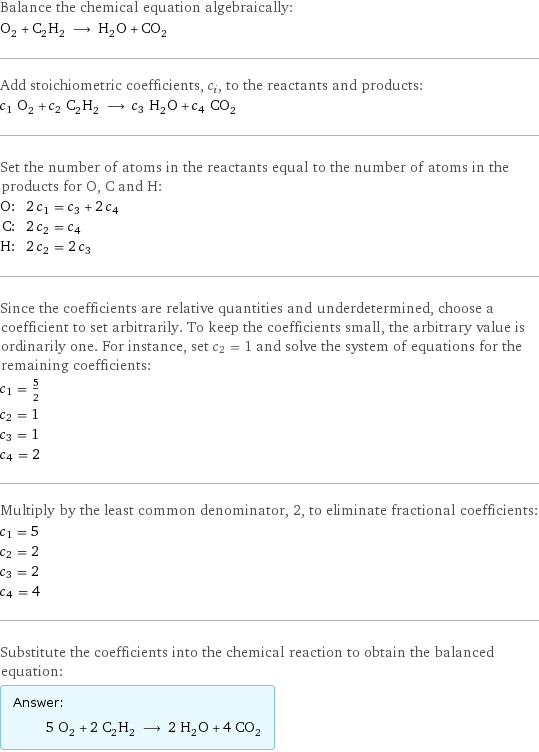
Balance the chemical equation algebraically: O_2 + C_2H_2 ⟶ H_2O + CO_2 Add stoichiometric coefficients, c_i, to the reactants and products: c_1 O_2 + c_2 C_2H_2 ⟶ c_3 H_2O + c_4 CO_2 Set the number of atoms in the reactants equal to the number of atoms in the products for O, C and H: O: | 2 c_1 = c_3 + 2 c_4 C: | 2 c_2 = c_4 H: | 2 c_2 = 2 c_3 Since the coefficients are relative quantities and underdetermined, choose a coefficient to set arbitrarily. To keep the coefficients small, the arbitrary value is ordinarily one. For instance, set c_2 = 1 and solve the system of equations for the remaining coefficients: c_1 = 5/2 c_2 = 1 c_3 = 1 c_4 = 2 Multiply by the least common denominator, 2, to eliminate fractional coefficients: c_1 = 5 c_2 = 2 c_3 = 2 c_4 = 4 Substitute the coefficients into the chemical reaction to obtain the balanced equation: Answer: | | 5 O_2 + 2 C_2H_2 ⟶ 2 H_2O + 4 CO_2
Structures

+ ⟶ +
Names

oxygen + acetylene ⟶ water + carbon dioxide
Reaction thermodynamics
Enthalpy
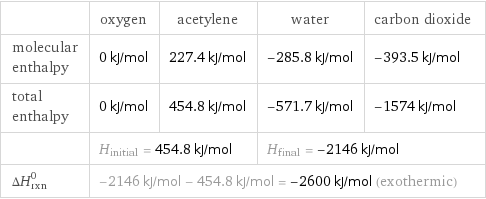
| oxygen | acetylene | water | carbon dioxide molecular enthalpy | 0 kJ/mol | 227.4 kJ/mol | -285.8 kJ/mol | -393.5 kJ/mol total enthalpy | 0 kJ/mol | 454.8 kJ/mol | -571.7 kJ/mol | -1574 kJ/mol | H_initial = 454.8 kJ/mol | | H_final = -2146 kJ/mol | ΔH_rxn^0 | -2146 kJ/mol - 454.8 kJ/mol = -2600 kJ/mol (exothermic) | | |
Gibbs free energy
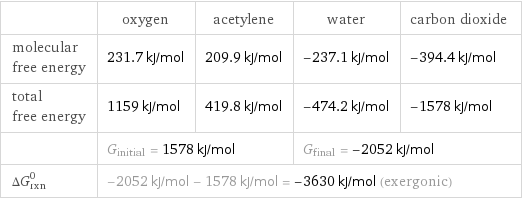
| oxygen | acetylene | water | carbon dioxide molecular free energy | 231.7 kJ/mol | 209.9 kJ/mol | -237.1 kJ/mol | -394.4 kJ/mol total free energy | 1159 kJ/mol | 419.8 kJ/mol | -474.2 kJ/mol | -1578 kJ/mol | G_initial = 1578 kJ/mol | | G_final = -2052 kJ/mol | ΔG_rxn^0 | -2052 kJ/mol - 1578 kJ/mol = -3630 kJ/mol (exergonic) | | |
Entropy
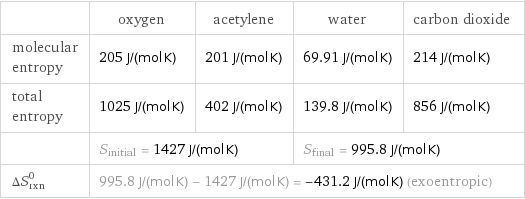
| oxygen | acetylene | water | carbon dioxide molecular entropy | 205 J/(mol K) | 201 J/(mol K) | 69.91 J/(mol K) | 214 J/(mol K) total entropy | 1025 J/(mol K) | 402 J/(mol K) | 139.8 J/(mol K) | 856 J/(mol K) | S_initial = 1427 J/(mol K) | | S_final = 995.8 J/(mol K) | ΔS_rxn^0 | 995.8 J/(mol K) - 1427 J/(mol K) = -431.2 J/(mol K) (exoentropic) | | |
Equilibrium constant
![Construct the equilibrium constant, K, expression for: O_2 + C_2H_2 ⟶ H_2O + CO_2 Plan: • Balance the chemical equation. • Determine the stoichiometric numbers. • Assemble the activity expression for each chemical species. • Use the activity expressions to build the equilibrium constant expression. Write the balanced chemical equation: 5 O_2 + 2 C_2H_2 ⟶ 2 H_2O + 4 CO_2 Assign stoichiometric numbers, ν_i, using the stoichiometric coefficients, c_i, from the balanced chemical equation in the following manner: ν_i = -c_i for reactants and ν_i = c_i for products: chemical species | c_i | ν_i O_2 | 5 | -5 C_2H_2 | 2 | -2 H_2O | 2 | 2 CO_2 | 4 | 4 Assemble the activity expressions accounting for the state of matter and ν_i: chemical species | c_i | ν_i | activity expression O_2 | 5 | -5 | ([O2])^(-5) C_2H_2 | 2 | -2 | ([C2H2])^(-2) H_2O | 2 | 2 | ([H2O])^2 CO_2 | 4 | 4 | ([CO2])^4 The equilibrium constant symbol in the concentration basis is: K_c Mulitply the activity expressions to arrive at the K_c expression: Answer: | | K_c = ([O2])^(-5) ([C2H2])^(-2) ([H2O])^2 ([CO2])^4 = (([H2O])^2 ([CO2])^4)/(([O2])^5 ([C2H2])^2)](../image_source/d856f529fa5efe9aae3f86bc251c4102.png)
Construct the equilibrium constant, K, expression for: O_2 + C_2H_2 ⟶ H_2O + CO_2 Plan: • Balance the chemical equation. • Determine the stoichiometric numbers. • Assemble the activity expression for each chemical species. • Use the activity expressions to build the equilibrium constant expression. Write the balanced chemical equation: 5 O_2 + 2 C_2H_2 ⟶ 2 H_2O + 4 CO_2 Assign stoichiometric numbers, ν_i, using the stoichiometric coefficients, c_i, from the balanced chemical equation in the following manner: ν_i = -c_i for reactants and ν_i = c_i for products: chemical species | c_i | ν_i O_2 | 5 | -5 C_2H_2 | 2 | -2 H_2O | 2 | 2 CO_2 | 4 | 4 Assemble the activity expressions accounting for the state of matter and ν_i: chemical species | c_i | ν_i | activity expression O_2 | 5 | -5 | ([O2])^(-5) C_2H_2 | 2 | -2 | ([C2H2])^(-2) H_2O | 2 | 2 | ([H2O])^2 CO_2 | 4 | 4 | ([CO2])^4 The equilibrium constant symbol in the concentration basis is: K_c Mulitply the activity expressions to arrive at the K_c expression: Answer: | | K_c = ([O2])^(-5) ([C2H2])^(-2) ([H2O])^2 ([CO2])^4 = (([H2O])^2 ([CO2])^4)/(([O2])^5 ([C2H2])^2)
Rate of reaction
![Construct the rate of reaction expression for: O_2 + C_2H_2 ⟶ H_2O + CO_2 Plan: • Balance the chemical equation. • Determine the stoichiometric numbers. • Assemble the rate term for each chemical species. • Write the rate of reaction expression. Write the balanced chemical equation: 5 O_2 + 2 C_2H_2 ⟶ 2 H_2O + 4 CO_2 Assign stoichiometric numbers, ν_i, using the stoichiometric coefficients, c_i, from the balanced chemical equation in the following manner: ν_i = -c_i for reactants and ν_i = c_i for products: chemical species | c_i | ν_i O_2 | 5 | -5 C_2H_2 | 2 | -2 H_2O | 2 | 2 CO_2 | 4 | 4 The rate term for each chemical species, B_i, is 1/ν_i(Δ[B_i])/(Δt) where [B_i] is the amount concentration and t is time: chemical species | c_i | ν_i | rate term O_2 | 5 | -5 | -1/5 (Δ[O2])/(Δt) C_2H_2 | 2 | -2 | -1/2 (Δ[C2H2])/(Δt) H_2O | 2 | 2 | 1/2 (Δ[H2O])/(Δt) CO_2 | 4 | 4 | 1/4 (Δ[CO2])/(Δt) (for infinitesimal rate of change, replace Δ with d) Set the rate terms equal to each other to arrive at the rate expression: Answer: | | rate = -1/5 (Δ[O2])/(Δt) = -1/2 (Δ[C2H2])/(Δt) = 1/2 (Δ[H2O])/(Δt) = 1/4 (Δ[CO2])/(Δt) (assuming constant volume and no accumulation of intermediates or side products)](../image_source/a26ae49d48f2dded0102767298feaedd.png)
Construct the rate of reaction expression for: O_2 + C_2H_2 ⟶ H_2O + CO_2 Plan: • Balance the chemical equation. • Determine the stoichiometric numbers. • Assemble the rate term for each chemical species. • Write the rate of reaction expression. Write the balanced chemical equation: 5 O_2 + 2 C_2H_2 ⟶ 2 H_2O + 4 CO_2 Assign stoichiometric numbers, ν_i, using the stoichiometric coefficients, c_i, from the balanced chemical equation in the following manner: ν_i = -c_i for reactants and ν_i = c_i for products: chemical species | c_i | ν_i O_2 | 5 | -5 C_2H_2 | 2 | -2 H_2O | 2 | 2 CO_2 | 4 | 4 The rate term for each chemical species, B_i, is 1/ν_i(Δ[B_i])/(Δt) where [B_i] is the amount concentration and t is time: chemical species | c_i | ν_i | rate term O_2 | 5 | -5 | -1/5 (Δ[O2])/(Δt) C_2H_2 | 2 | -2 | -1/2 (Δ[C2H2])/(Δt) H_2O | 2 | 2 | 1/2 (Δ[H2O])/(Δt) CO_2 | 4 | 4 | 1/4 (Δ[CO2])/(Δt) (for infinitesimal rate of change, replace Δ with d) Set the rate terms equal to each other to arrive at the rate expression: Answer: | | rate = -1/5 (Δ[O2])/(Δt) = -1/2 (Δ[C2H2])/(Δt) = 1/2 (Δ[H2O])/(Δt) = 1/4 (Δ[CO2])/(Δt) (assuming constant volume and no accumulation of intermediates or side products)
Chemical names and formulas

| oxygen | acetylene | water | carbon dioxide formula | O_2 | C_2H_2 | H_2O | CO_2 name | oxygen | acetylene | water | carbon dioxide IUPAC name | molecular oxygen | acetylene | water | carbon dioxide
Substance properties
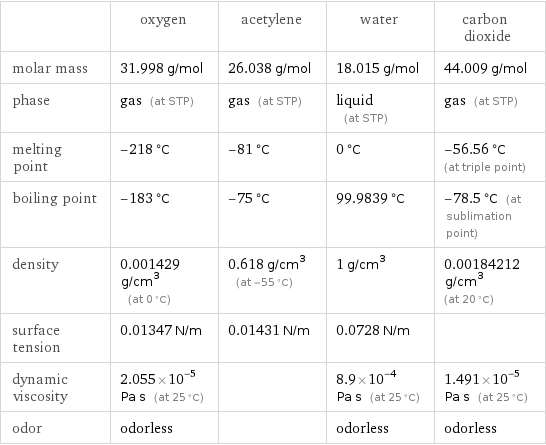
| oxygen | acetylene | water | carbon dioxide molar mass | 31.998 g/mol | 26.038 g/mol | 18.015 g/mol | 44.009 g/mol phase | gas (at STP) | gas (at STP) | liquid (at STP) | gas (at STP) melting point | -218 °C | -81 °C | 0 °C | -56.56 °C (at triple point) boiling point | -183 °C | -75 °C | 99.9839 °C | -78.5 °C (at sublimation point) density | 0.001429 g/cm^3 (at 0 °C) | 0.618 g/cm^3 (at -55 °C) | 1 g/cm^3 | 0.00184212 g/cm^3 (at 20 °C) surface tension | 0.01347 N/m | 0.01431 N/m | 0.0728 N/m | dynamic viscosity | 2.055×10^-5 Pa s (at 25 °C) | | 8.9×10^-4 Pa s (at 25 °C) | 1.491×10^-5 Pa s (at 25 °C) odor | odorless | | odorless | odorless
Units
